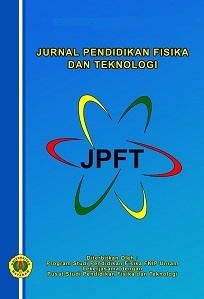Peningkatan Kerja Sinergis Melalui Pembelajaran Fisika Berbasis Potensi Lokal
DOI:
10.29303/jpft.v5i1.934Published:
2019-03-06Issue:
Vol. 5 No. 1 (2019): Januari - JuniKeywords:
Living Values, Synergistic Work, Physics Learning, Local PotentialArticles
Downloads
How to Cite
Downloads
Metrics
Abstract
The 21st century is a period of rapid development of information and communication technology. Therefore, various life skills and living values are needed to balance them. One of the living values that is really needed is the synergistic work that can be grown through local potential physics-based learning. This study aims to determine whether there is an increase in student synergistic work through local potential physics-based learning. The research method that will be used is a quasi experiment. The instruments were observation sheets and questionnaires. Data analysis used quantitative and qualitative descriptive analysis. The results showed that there was an increase in synergistic work of students who conducted physics learning based on local potential of 0.52381 with the medium categoryReferences
Agung, S. L. 2015. The Development of Local Wisdom-Based Social Science Learning Model with Bengawan Solo as the Learning Source. American International Journal of Social Science. 4(4), 51-58.
Ardan, A. S., Ardi, M., & Hala, Y. 2015. Needs Assessment to Development of Timor. International Education Studies;8(4). DOI:10.5539/ies.v8n4p52.
Asmani, J. M. 2012. Pendidikan Berbasis Keunggulan Lokal. Yogyakarta: DIVA Press.
BPS (Badan Pusat Statistik). 2018. Keadaan Ketenagakerjaan Indonesia Februari 2018. No. 42/05/Th. XXI, 07 Mei 2018.
Chusorn, P., Ariratana, W., & Chusorn, P. 2014. Strategy Challenges The Local Wisdom Applications Sustainability In Schools. Procedia - Social and Behavioral Sciences 112: 626 ââ¬â 634. DOI:10.1016/j.sbspro.2014.01.1210.
Collette, A. T. & Chiappette, E. L. (1994). Science Instruction in The Middle and Secondary Schools. New York: Macmillan Publishing Company.
Covey, S.R. 2010. The 7 Habits of Highly Effective People (Ed. Lyndon Saputra). Tangerang: Binarupa Aksara.
Hake, R. R. 1998. Interactive-Engagement Versus Traditional Methods: A Six-Thousand-Student Survey Of Mechanics Test Data For Introductory Physics Courses. Am. J. Phys. 66(1), 64-74.
Hariyadi, P. 2010. Penguatan Industri Penghasil Nilai Tambah Berbasis Potensi Lokal peranan Teknologi Pangan untuk Kemandirian Pangan. Jurnal PANGAN,19(4).
Joice, B., Weil, M., & Calhoun, E. 2009. Models Teaching. Boston: Allyn & Bacon A. Simon & Schuster Company.
Kesiman, M. W. A. & Ketut, A. 2012. The Implementation of Hypertext-based Learning Media for a Local Cultural Based Learning. Journal of Information Technology Education: Innovations in Practice, 11, 377-385. http://www.jite.org/documents/Vol11/JITEv11IIPp377-365Kesiman1115.pdf.
Klienger, A. & Sherman, G. 2015. Physics textbooks: do they promote or inhibit studentsââ¬â¢ creative thinking. Physics Education 50(3): 305-309.
Mardapi, D. 2008. Teknik Penyusunan Instrumen Tes dan Nontes. Yogyakarta: Mitra Cendekia Press.
Mungmachon, R. 2012. Knowledge and Local Wisdom: Community Treasure. International Journal of Humanities and Social Science, 2(13), 174-181. www.ijhssnet.com.
Oktaviani, W., Gunawan, G., & Sutrio, S. 2017. Pengembangan Bahan Ajar Fisika Kontekstual Untuk Meningkatkan Penguasaan Konsep Siswa. Jurnal Pendidikan Fisika dan Teknologi, 3(1), 1-7.
Prijosaksono, A. & Sembel, R. 2002. Control Your Life: Aplikasi Manajemen Diri dalam Kehidupan Sehari-hari. PT Elex Media Komputindo: Jakarta.
Rokhmat, J. 2015. Penanaman Karakter Positif Pembelajar Melalui Pembahasan Fenomena-Fenomena Fisika Dan Pendekatan Analogi (Hasil Kajian Perkuliahan Fisika Dasar). Jurnal Pendidikan Fisika dan Teknologi, 1(1), 52-60.
Sahlberg, P. 2007. Education Policies For Raising Student
Learning: The Finnish Approach. Journal of Education Policy, 22(2), 147ââ¬â171. DOI: 10.1080/02680930601158919.
Sarah, S. & Maryono. 2014. Pengembangan Perangkat pembelajaran Berbasis Potensi Lokal untuk Meningkatkan Living Values Peserta Didik SMA di Kabupaten Wonosobo. Technoscientia, 6(2).
Sarah, S. & Maryono. 2014. Keefektivan Pembelajaran Berbasis Potensi Lokal dalam Pembelajaran Fisika SMA dalam Meningkatkan Living Values. Jurnal Pendidikan Sains, 2(1).
Sarah, S., Prasetyo, Z. K., & Wilujeng, I. 2018. Integration of living values into physics learning based on local potentials. J. Phys.: Conf. Ser. 1022 012026.
Sarah, S. 2018. Peningkatan Keterampilan Berpikir Kreatif Melalui Pembelajaran Fisika Berbasis Potensi Lokal. Jurnal Inovasi Pendidikan Fisika dan Riset Ilmiah, 2(2), 84 ââ¬â 94.
Scheider, W. 1980. 27 Commandments for Physics Teachers. The Physics Teacher, 18 (1), 32.
Suastra, I. W. 2005. Reconstruct the original Science (Indigenous Science) in order to develop local cultural-based science education in schools: Etnosains Study on Community Penglipuran Bali (Unpublished dissertation). Bandung: Graduate Education University of Indonesia.
Suastra, I. W. dan Nengah. 2010. Science-based models of local culture to develop Basic Competence in science and value of local wisdom in junior high School. Journal of education and the teaching of State Univ. Singaraja, 43(2), 8-16.
Trilling, B & Fadel, C. 2009. San Francisco: John Wiley & Sons, Inc.
Triwiyono, T., & Adiwikarta, S. 2015. Identifikasi Pengetahuan Tradisional Masyarakat Sentani dan Peluangnya untuk Pembelajaran Fisika. Jurnal Pendidikan Fisika dan Teknologi, 1(1), 77-81.
Zoller, U. 2013. Science, Technology, Environment, Society (STES) Literacy for Sustainability: What Should It Take in
Chem/Science Education? Educ.quÃÂm, 24(2), 207-21Ãâ.
Author Biography
Siti Sarah, Sains Al Quran University
License
Authors who publish with Jurnal Pendidikan Fisika dan Teknologi (JPFT) agree to the following terms:
- Authors retain copyright and grant the journal right of first publication with the work simultaneously licensed under a Creative Commons Attribution License 4.0 International License (CC-BY-SA License). This license allows authors to use all articles, data sets, graphics, and appendices in data mining applications, search engines, web sites, blogs, and other platforms by providing an appropriate reference. The journal allows the author(s) to hold the copyright without restrictions and will retain publishing rights without restrictions.
- Authors are able to enter into separate, additional contractual arrangements for the non-exclusive distribution of the journal's published version of the work (e.g., post it to an institutional repository or publish it in a book), with an acknowledgement of its initial publication in Jurnal Pendidikan Fisika dan Teknologi (JPFT).
- Authors are permitted and encouraged to post their work online (e.g., in institutional repositories or on their website) prior to and during the submission process, as it can lead to productive exchanges, as well as earlier and greater citation of published work (See The Effect of Open Access).











